Welcoming Real Americans
Julie Lythcott-Haims Comes to Parker Once Again
On Tuesday, December 5, Principal Dan Frank took Parker’s auditorium stage to introduce Julie Lythcott-Haims, author of “Real American: A Memoir,” (2017) an account of growing up a biracial black woman in America. After a few words of preface, Frank waved his hand to not Lythcott-Haims but signal sophomore Joryin Pender to join him on stage.
Pender skipped up the steps on the left side of the stage and took quick strides to the podium. She paused — inhaling deeply as she surveyed the room full of faces through her gold wired glasses. Audience members were scattered across the room, most sitting at least four or five seats from the next.
Pender let out a sharp exhale and began, as Lythcott-Haims stood nearby, smiling while taking smartphone photos of Pender. “This isn’t a poem about women’s rights,” Pender said. “This is a poem about how badass Mother Mary was.”
With degrees from Stanford University, Harvard Law School, and California College of the Arts, and careers in both law and academia behind her, Lythcott-Haims is now a best-selling author of two books. Before the memoir came “How to Raise an Adult” (2015). As Lythcott-Haims has been touring the country visiting different schools in recent weeks, she has been asking schools to choose one student — preferably a student of color, she has said — to introduce her. For Parker, this student was Pender, who identifies as Black American.
“Every time there is a talent show I try to share a poem, and Ms. Jurgensen noticed that and asked me if I would like to use my poetry to introduce Julie,” she said, “and of course I agreed! My guidelines were very loose. The only rule they had was ‘It must be under three minutes.’ But besides that, they told me I could write about whatever I wanted.”
Pender threw her first draft into the trash. Then the direction of the piece became clear. “I decided to write a religious poem about what Mother Mary would be like in this day and age,” she said. “I analyzed her and took the things that we are privileged enough to have in America—such as women’s rights, civil rights, technology, electricity—and I applied them to her.”
When Lythcott-Haims arrived at Parker on that snowy Tuesday night, it was the first time Pender had ever spoken to her. “I thought she was a spectacular woman,” Pender said. “She is a person of color, yet she has experienced both sides of the spectrum. She is mixed—she comes both from a white background and a black background — and I think it’s really important that she talks about both of those experiences and how she has claimed both identities.”
When Pender closed her poem, Lythcott-Haims, in a long black shirt with sleeves rolled up past her elbows and cuffed dark blue jeans, shuffled hastily across the stage, as the crowd gave Pender a round of applause.
Lythcott-Haims thanked Pender and introduced herself, but just as Pender turned to walk off stage, Lythcott-Haims stopped her. “Stay up here, kiddo,” she said. “It’s essential that we pay artists.” Lythcott-Haims embraced Pender and handed her a signed copy of the memoir.
Lythcott-Haims has visited 18 cities for her book tour thus far, presenting her authentic story of what it was like growing up a biracial black woman in a country “so obsessed with who does and doesn’t belong.”
At Parker she started her story like this: “In the lead up to the 2008 presidential election, a persona stepped to the forefront of public consciousness. That of the ‘real American.’ These ‘real Americans’ found a voice in their candidates, grew in number to become a mob who raised slogans, signs, fists, and arms, who longed to make America great–normal, regular, white—again.”
“‘If you don’t like it, go back to where you came from.’”
“There is no back to where I came from. You stole my homeland from me. Me from my homeland.” She proceeds to tell the story of her unique journey.
“I’ve written this memoir,” she said. “Like any memoir, it’s a story about me, about race, and racism, and forging a self I could love in a country where black lives weren’t meant to matter.”
Lythcott-Haims went on to tell the story of her journey, beginning with her great-great-great-great grandmother, Sylvie, who was a slave in South Carolina in the late 1700’s. Sylvie had three children, the father of whom was her master who raped her. “There is no consent in slavery,” Lythcott-Haims said. “I have dedicated this book to Sylvie, even though she was only counted as three fifths of a person. I come from people who survived what America did to them. Ain’t I a real american?”
Even with the great progress that has been achieved since the 1700’s, Lythcott-Haims choked up, eyes filling with tears and on the verge of spilling down her cheeks as she told stories of racism she encountered in her childhood. “On my 17th birthday, my best friend Dianna made me a huge birthday locker sign filled with words and images cut from the pages of ‘Tiger Beat,’ ‘Seventeen,’ and other teen magazines,” Lythcott-Haims read from her book. “She’d woken up extra early to get to school on time to tape it to my locker before my arrival. I could already see the birthday sign on my locker 50 lockers in front of me with shimmering silver ribbons taped to the top and the sides spiralling out into the hall. I felt a surge of anticipation of the attention I would get that day.”
Little did Lythcott-Haims know that soon after she had grabbed her books from the glimmering locker would someone take a thick black marker to scribble the N-word three times on her birthday sign. Shocked, she walked into a school office and asked if she could borrow a black magic marker. “As the silence pressed down around me, I took the cap off the marker and started to draw neat black lines over each iteration of the word,” she said. “At day’s end I took the sign home. In the privacy of my home, I pulled my senior scrapbook off the bookshelf above my desk and opened it to the first blank page. There I pasted my birthday locker sign accordion style so it could be completely unfolded to resemble what it had looked like hanging on my locker.”
Pender says Lythcott-Haims’s story will always stand out to her. “I can’t imagine holding on to that poster for such a long time,” she said. “Instead of letting it be a negative in her life, she turned it into a positive. I think that just shows how strong she is.”
In 1985, Lythcott-Haims wrote her college applications, and in April she accepted an offer of admission to Stanford University. “A classmate had applied to Stanford, but had not gotten in,” Lythcott-Haims said. “We were both in precalculus together, the highest math class offered at our school, and it was held during the 7th and final period of the day. One day, right after the bell rang, his father walked in, sat down in an empty desk next to mine, and started to talk to me in a playful tone. ‘Do you think it’s fair that you got into Stanford over my son, when his scores were higher?’ The boy was not the President of the student council, our grades were roughly the same, but I had stolen his spot at Stanford with my blackness.”
In reaction to this story, Pender was appalled. “Julie went to a very impressive college, that is very impressive to get into,” she said. “People look at you like you only got into that college because you are a person of color. But she is living proof that she got into college off of her own talent.”
As Lythcott-Haims opened the floor to questions, she noticed that the room was hesitant. “It’s not easy to talk about this,” she said. “I promise, I know.”
The advice she ended up giving to her audience was to be “bold enough to seek to know the experience of other people.” She added, “Stop seeing each other as ‘the other,’ and start seeing each other as human.”
According to Lythcott-Haims, humans are lacking compassion in this world right now, but there is still hope. “All we have is the ability to love each other,” she said. “And that’s a lot.”







